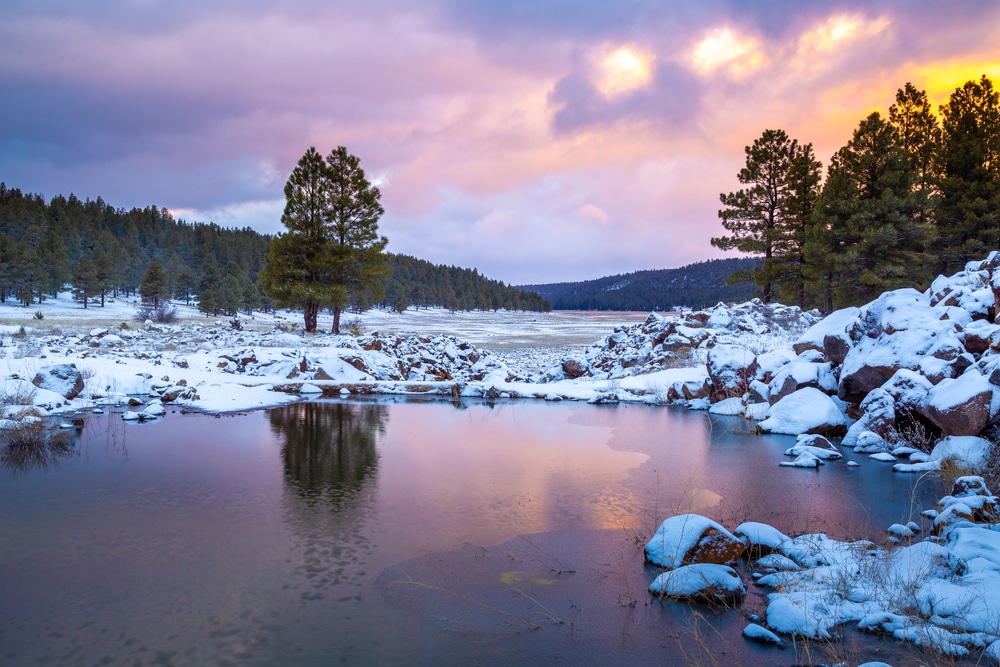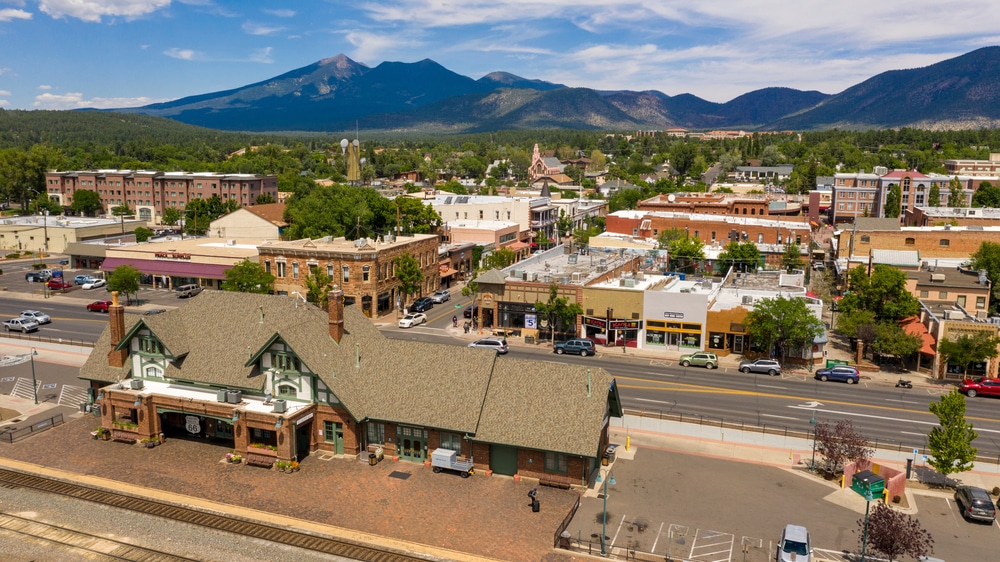- Privacy
- Terms
- Stay Connected
Northern Arizona stands as a captivating realm where ancient landscapes meet vibrant communities, where the Colorado River carves through millennia of geological history, and where diverse cultures have left their enduring imprint. This remarkable region stretches from the Grand Canyon’s majestic rim to the verdant ponderosa forests of the Mogollon Rim, and from the red rock formations of Sedona to the volcanic fields surrounding Flagstaff.
Unlike Southern Arizona’s Sonoran Desert environment, Northern Arizona presents dramatic elevation changes that create distinct climate zones—from high desert plateaus to alpine forests. Summer brings pleasant warmth to higher elevations while winter transforms the landscape with snow-dusted pines and creates a playground for cold-weather enthusiasts. Spring and fall offer mild temperatures ideal for exploring the region’s countless outdoor attractions.


The story of Northern Arizona begins with Indigenous peoples—the Navajo, Hopi, Havasupai, and others—who have called this land home for thousands of years. Their presence shaped the cultural landscape long before Spanish explorers ventured north in the 16th century. The late 1800s brought pioneers, miners, and ranchers who established many of today’s communities. The arrival of the railroad in the 1880s opened the region to tourism and commerce, forever changing its economic trajectory.
Today’s Northern Arizona represents a fascinating blend of economies—tourism drives communities near natural wonders, while agriculture, forestry, and renewable energy create sustainable livelihoods. Throughout the region, the cultural fusion of Native American traditions, Hispanic influences, pioneer heritage, and contemporary arts creates a rich tapestry that defines Northern Arizona’s unique character.
Northern Arizona houses some of the world’s most spectacular geological formations, crowned by the incomparable Grand Canyon. This colossal chasm reveals two billion years of Earth’s history in its layered walls, while the Colorado River continues its patient sculpting below. The San Francisco Peaks near Flagstaff—Arizona’s highest mountains—rise as dormant volcanic sentinels, their slopes transitioning from desert scrub to alpine tundra.
The region’s geological tapestry extends to the Painted Desert’s multicolored badlands, the towering sandstone spires of Monument Valley, and the mysterious meteor crater near Winslow—a massive impact site preserving cosmic history. Throughout Northern Arizona, ancient lava flows, eroded escarpments, and fossil-rich sedimentary deposits tell Earth’s story in vivid detail.
This landscape nurtures remarkable ecological diversity. Ponderosa pine forests shelter elk and black bear in the high country, while desert plateaus host uniquely adapted plant communities. The Colorado River system—including Lake Powell and Lake Mead—has created riparian zones that sustain critical wildlife corridors. Protected areas including Grand Canyon National Park, Wupatki National Monument, and Coconino National Forest preserve these treasures for future generations.
Walk through Northern Arizona and you’re treading on layers of human history. Ancient pathways used by Indigenous peoples evolved into Spanish exploration routes, which later became wagon trails, railroads, and eventually Route 66—”The Mother Road” that still draws travelers seeking America’s storied past.
The region’s cultural narrative is written in petroglyphs etched on canyon walls, in the stone pueblos at Walnut Canyon and Wupatki, and in living traditions maintained by the Navajo and Hopi people. Spanish missions established cultural crossroads, while pioneer homesteads and mining camps grew into towns that balanced frontier grit with surprising sophistication.
Today, this heritage lives on in museums like Flagstaff’s Museum of Northern Arizona, in trading posts showcasing Indigenous artistry, and in annual events celebrating diverse traditions. Historic preservation efforts have saved territorial-era buildings, vintage motels along Route 66, and mining structures that recall the region’s industrial past—creating authentic connections to Northern Arizona’s multilayered story.
Northern Arizona offers year-round outdoor experiences for every interest and ability. The Colorado River provides world-class rafting through the Grand Canyon’s heart, while Lakes Powell and Mead invite boating, fishing, and watersports against spectacular backdrops of red rock canyons.
On land, hundreds of miles of trails welcome hikers, mountain bikers, and equestrians to explore destinations from Sedona’s red rock formations to the pine-scented paths of the Mogollon Rim. Rock climbers test their skills on volcanic cliffs and sandstone walls, while off-road enthusiasts navigate rugged backcountry routes to remote vistas.
Winter transforms the San Francisco Peaks into a snowy playground at Arizona Snowbowl, while cross-country skiers glide through silent forests. For those preferring passive recreation, scenic drives like Oak Creek Canyon and the Kaibab Plateau offer accessible beauty, while stargazers discover why Flagstaff earned the world’s first International Dark Sky City designation.
Despite challenging conditions, Northern Arizona’s agricultural traditions flourish through innovation and respect for traditional knowledge. High desert ranches raise cattle on vast grasslands using sustainable grazing techniques, while farms nestled in river valleys produce crops from apples to zucchini. Vineyards thrive in Verde Valley microclimates, creating an emerging wine region gaining national recognition.
The region pioneers desert-adapted living strategies through water conservation, renewable energy, and sustainable building practices. Solar installations harness abundant sunshine, while wind farms along the Mogollon Rim generate clean energy. Communities have developed sophisticated water management systems that honor the precious nature of this desert resource.
Northern Arizona’s scientific community studies climate adaptation, forest health, and astronomical discovery, making the region a center for research addressing planetary challenges. From traditional rainwater harvesting techniques preserved on tribal lands to cutting-edge climate research at Northern Arizona University, the region demonstrates how human ingenuity can thrive in demanding environments.
Northern Arizona’s diverse communities each offer distinctive experiences while contributing to the region’s collective character:
Flagstaff serves as the region’s mountain hub, blending university town energy with outdoor adventure against the backdrop of the San Francisco Peaks. Sedona enchants with its red rock vistas, spiritual connections, and thriving arts scene. Prescott preserves its territorial capital heritage around a charming courthouse square, while neighboring Prescott Valley represents modern growth and family-friendly amenities.
Historic Williams and Winslow showcase Route 66 nostalgia, with the former serving as “Gateway to the Grand Canyon” and the latter celebrating its Eagles song fame. Jerome clings dramatically to Cleopatra Hill as a reborn mining town turned artistic haven, while Verde Valley communities including Cottonwood, Camp Verde, and Clarkdale offer wine country pleasures and river recreation.
The White Mountains region encompasses Show Low, Pinetop-Lakeside, Snowflake, and Taylor—communities offering cool mountain retreats and outdoor recreation. Gateway communities like Tusayan and Page provide services for exploring iconic natural wonders, while Holbrook combines Route 66 heritage with Petrified Forest proximity.
Each community preserves its distinct character while contributing to Northern Arizona’s diverse appeal. Dedicated pages for each town will guide you deeper into their individual stories and attractions.
Northern Arizona rewards visitors in every season, though experiences vary dramatically with the calendar. Summer brings perfect temperatures to high-elevation communities like Flagstaff and the White Mountains, while spring and fall offer ideal conditions for exploring mid-elevation destinations like Sedona and Prescott. Winter delivers snow sports opportunities alongside the novelty of desert snowscapes.
The region’s vastness requires thoughtful planning—communities may appear close on maps but can be separated by significant drives through dramatic terrain changes. Major highways including I-40, I-17, and US-89 provide efficient access, while scenic byways like Oak Creek Canyon and the Kaibab Plateau offer memorable alternatives.
For first-time visitors, consider structuring your exploration around geographical clusters: the Grand Canyon/Williams/Tusayan area; the Flagstaff/Sedona/Verde Valley communities; the Prescott/Prescott Valley region; or the White Mountains towns. Allow ample time between destinations to accommodate both driving distances and the inevitable unplanned discoveries that make travel memorable.
Northern Arizona invites you to discover a world where natural splendor meets human heritage in ways found nowhere else. Here, you can stand at the edge of Earth’s most magnificent canyon as condors soar below, walk among red rocks that seem to radiate their own light at sunset, trace the footsteps of ancient peoples and Route 66 travelers, and gaze at stars through some of the world’s clearest skies.
Whether you seek outdoor adventure, cultural exploration, scientific discovery, artistic inspiration, or simply a landscape that will forever change your perspective, Northern Arizona offers experiences that resonate long after your visit:
Begin your journey by exploring our community profiles, each offering detailed insights into the places that make Northern Arizona an unforgettable destination. The landscape has been waiting for millennia—your adventure begins now.